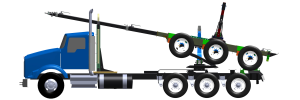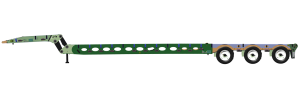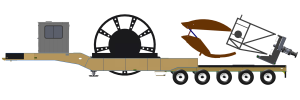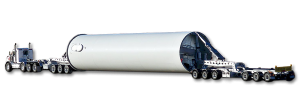The oil and gas industry’s heavy hauling operations demand meticulous planning, skilled professionals, and unwavering adherence to stringent safety measures.
Safety should always be the top priority to ensure the well-being of personnel and protect valuable assets.
In this comprehensive guide, we present 17 important safety tips for heavy hauling in the oil and gas industry.
Important Safety Tips for Heavy Hauling
1. Thorough Route Planning
Before embarking on a heavy hauling journey, meticulous route planning is essential. Identify potential obstacles and ensure the chosen route complies with all relevant regulations and permits.
You should know every highway, road, and exit you plan to take on your route.
Check with regulatory bodies such as Alberta Transportation and BC Ministry of Transportation and Infrastructure to get real-time updates for a safer and more efficient transportation process.
2. Proper Load Securing
Utilize appropriate tie-downs, chains, and straps to secure the load in accordance with industry standards and prevent accidents caused by loose debris on the road.
When heavy hauling equipment, conduct thorough pre-departure inspections of these restraints, checking for integrity and functionality. Regularly inspect your restraints throughout the journey to ensure they remain intact, and check that the load has not shifted out of place.
To ensure the safety of both the driver and others on the road, account for load height restrictions and potential encounters with overpasses.
3. Routine Equipment Inspections
Regular inspections of hauling equipment, including trucks and trailers, are crucial for identifying potential issues before they escalate. Perform routine walkarounds and closely inspect tires, brakes, lights, and critical components.
4. Hire Experienced Operators
Choose experienced operators for heavy-haul operations to mitigate the risks associated with driving.
Every truck driver should keep a safe following distance from other drivers, drive defensively, stay the speed limit, and avoid distracted driving. Experienced drivers should understand proper load securing, and how to evaluate load heights & weights.
5. Driver Training and Certification
Drivers involved in heavy hauling operations should undergo specialized training and obtain relevant certifications. Continuous training programs help drivers in the trucking industry stay updated on the latest safety practices.
In both British Columbia and Alberta, organizations like the BC Trucking Association (BCTA), Justice Institute of British Columbia (JIBC), Alberta Motor Transport Association (AMTA), and Southern Alberta Institute of Technology (SAIT) offer comprehensive training programs to ensure truck drivers are well-versed in the unique challenges associated with transporting heavy loads in the oil and gas industry.
These programs cover a range of topics, including load securing practices, route planning, emergency preparedness, and compliance with local, state, and federal regulations, contributing to the overall safety and professionalism of drivers in the industry.
6. Communication Protocols
Establish clear communication protocols between drivers, escort vehicles, and base operations. Utilize two-way radios, smartphones, or other communication devices for constant contact between dispatch and your drivers throughout the journey.
7. Invest in Telematics
Investing in telematics systems, which integrate telecommunications and informatics, provides constant location data, alerts, and records driver behavior, ensuring safety & efficient operations.
Telematics involve the use of GPS technology, sensors, and communication devices to gather and transmit real-time information about the location, movement & status of the trucking rig and equipment.
If a truck deviates from its planned route, you’ll get an instant notification. Telematics systems also provide valuable insights into driver safety, fuel efficiency, idling time & potential aggressive driving behaviors.
Overall, leveraging telematics contributes to safer operations, improved logistics, and better fleet management.
8. Weather Monitoring
Keep a close eye on weather forecasts along the planned route. Extreme weather conditions can significantly impact the safety of heavy hauling operations.
If snowy, icy conditions are in the forecast, operators should install tire chains to avoid loss of traction and ensure a safe journey.
Here are some resources for weather monitoring in BC and Alberta, Canada.
Environment Canada: The official weather agency for Canada provides detailed weather forecasts, warnings, and historical data for various regions, including BC and Alberta. You can access local forecasts, radar imagery, and climate information on their website.
BC Wildfire Service: If you’re interested in wildfire conditions, BC Wildfire Service offers real-time updates on active wildfires, fire danger ratings, and evacuation alerts. Monitoring this service is crucial during fire seasons.
Alberta Emergency Alert: For weather-related emergencies and alerts specific to Alberta, the Alberta Emergency Alert system provides timely notifications via email, SMS, or social media. It covers severe weather, floods, wildfires, and other hazards.
Windy: The Windy platform provides a weather radar, wind, and waves forecast for various activities such as kiting, surfing, paragliding, piloting, and sailing. It offers a worldwide animated weather map with easy-to-use layers and precise spot forecasts.
9. Emergency Preparedness
Equip your drivers and support personnel with the necessary tools and training to handle emergencies effectively. Regularly conduct drills to ensure everyone is well-prepared for unexpected situations.
10. Compliance with Regulations
Strictly adhere to local, state / provincial, and federal regulations governing heavy hauling in the oil and gas industry. Stay informed about changes in regulations and ensure all necessary permits are obtained.
In Canada, check with Transport Canada’s Road Transportation section for information on federal regulations and permits related to large commercial vehicle & heavy equipment hauling. Note that each province has its own transportation department responsible for regulations within its jurisdiction.
11. Post-Journey Evaluations
After completing a journey with a heavy load, conduct thorough post-journey evaluations to identify areas for improvement. Collect feedback from drivers and assess the effectiveness of your safety measures.
12. Conduct a Reconnaissance Mission
Before dispatching a truck, conduct a reconnaissance mission to double-check road conditions and reduce risks during transport.
13. Know the Rules
Understand and comply with road rules in different states and provinces to avoid violations and ensure smooth operations across jurisdictions.
Wear a seatbelt, abide by speed limits, and avoid distracted driving.
Keep a safe stop distance between you and the vehicle in front of you (at least 7 seconds) to avoid collisions if you need to make a sudden stop.
14. Choose the Right Trailer
Select the appropriate trailer based on the load’s weight and dimensions. Match the right trailer to ensure safe and legal transportation.
In the oil and gas industry in Canada or the USA, Peerless stands out as a reliable choice for a wide range of Oilfield trailers and Drilling & well servicing trailers.
Our oilfield product line includes:
- Rock Over Mud Trailers: https://peerless.ca/trailers/rock-over-mud-trailers/
- Coil Tube Units (CTUs): https://peerless.ca/trailers/coiled-tubing-unit-ctu/
- Mast Drilling: https://peerless.ca/trailers/mast-drilling/
- Fracturing and Well Stimulation: https://peerless.ca/trailers/fracturing-and-well-stimulation/
- Lowbed trailers: https://peerless.ca/trailers/oilfield-lowbed/
- Float trailers: https://peerless.ca/trailers/floats/
- Low profile floats: https://peerless.ca/trailers/low-profile-float/
- RGN trailers: https://peerless.ca/trailer-category/rgn-trailer
- Jeeps: https://peerless.ca/trailer-category/jeeps-oilfield
- Boosters: https://peerless.ca/trailer-category/booster-trailers
With a company history dating back to 1944, we specialize in designing innovative trailers for the oil and gas industry, ensuring quality and reliability. Our commitment to excellence is underscored by decades of industry leadership, a state-of-the-art Lean production facility in British Columbia, and a team with an average seniority of 15 years.
We optimize payload through careful design and production, drawing on our extensive experience.
15. Pay Attention to Both Length and Weight
When choosing a trailer, consider both length and how much weight you’ll need to haul. To prevent accidents during transit, make sure your vehicle and trailer are suitable for the load’s dimensions.
16. Emphasize Vehicle Maintenance
Prioritize regular checks and maintenance of oilfield vehicles to ensure they operate efficiently and safely, preventing accidents caused by mechanical failures.
17. Stay Alert and Get Adequate Sleep
Encourage drivers to stay alert and avoid distractions while driving. Ensure they get adequate sleep and are well rested to maintain focus and quick reaction times during challenging situations.
A study conducted on 949 truck drivers in Italy found that insomnia significantly impacts motor vehicle accidents (MVAs) and near-miss accidents (NMAs). Truck drivers with insomnia had an almost two-fold risk of driving accidents and a more than three-fold increased risk of near-miss accidents compared to non-insomniac drivers.
This study found that insomnia was prevalent in 27.5% of the drivers sampled. Screening commercial drivers for insomnia is highly recommended to improve health and safety on the road.
If your drivers need sleep on long-haul routes without adequate hotels & motels, check out the DC-Max cab extender.






0 Comments